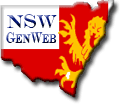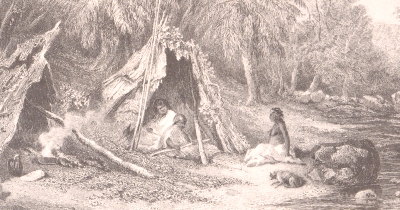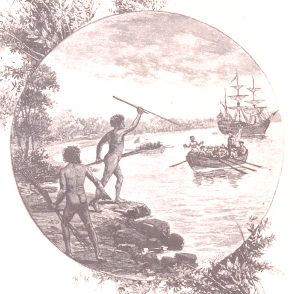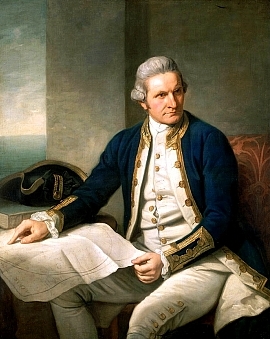|
|
New South Wales (NSW) is Australia's most populous state. It is located in the south-east of the country, north of Victoria and south of Queensland. It was founded in 1788 and originally comprised much of the Australian mainland (including Lord Howe and Norfolk Islands). During the 19th century large areas were successively separated to form the British colonies of Tasmania (1825) South Australia (1836), Victoria (1855), and Queensland (1859). In 1901 these colonies plus Western Australia federated to form Commonwealth of Australia.
New South Wales is bordered on the north by Queensland, on the west by South Australia and on the south by Victoria; its coastline borders the Tasman Sea. Within New South Wales there are two Federal enclaves - Australian Capital Territory (ACT); and Jervis Bay Territory. Although geographically diverse from region to region, New South Wales can roughly be divided into four topographical regions:
The form of the Government of New South Wales is prescribed in its Constitution, which dates from
1856; although it has been amended many times since then. Since 1901 New South Wales has been a state of the Commonwealth of
Australia; the Australian Constitution regulates its relationship with the Commonwealth.
In practice, however, the independence of the Australian states has been greatly eroded by the increasing financial domination of the Commonwealth. Indigenous Culture (Pre-Colonisation) Indigenous Australians are the first human inhabitants of the Australian continent and its nearby islands. There is no clear or accepted origin of the Indigenous people of Australia. History suggests that they migrated to Australia through Southeast Asia yet they are not demonstrably related to any known Asian or Polynesian population. There is evidence of genetic and linguistic interchange between Australians in the far north and the Austronesian peoples of modern-day New Guinea and the islands, but this may be the result of recent trade and intermarriage.
Aboriginal Encampment Recent DNA studies suggest that Indigenous Australians may be of African descent; having travelled via India and Asia before settling in what we know today as the Australian continent. While the exact date of their arrival may be indeterminate, general accord places them on the land as far back as 40,000-50,000 years BP (Before Present - units of time counted backwards to the past, as used in radiocarbon dating). Mungo Man, whose remains were discovered in 1974 near Lake Mungo in New South Wales, is the oldest human yet found in Australia. Lake Mungo is one of several dry lakes in the World Heritage listed Willandra Lakes Region. Although the exact age of Mungo Man is in dispute, consensus is that he is at least 40,000 years old. Stone tools also found at Lake Mungo have been estimated, based on stratigraphic association to be about 50,000 years old. Since Lake Mungo is in south-eastern Australia, many archaeologists have concluded that humans must have arrived in north-west Australia at least several thousand years earlier. Of particular significance is the way in which Mungo Man was laid to rest. The body was sprinkled with red ochre, early evidence of a sophisticated and artistic burial practice. This aspect of the discovery has been particularly significant to Indigenous Australians, since it indicates that certain cultural traditions have existed on the Australian continent for much longer than previously thought. Based on evidence of osteoarthritis in the lumbar vertebrae, and severe wear on the teeth, it seems likely that Mungo Man was quite old when he died. Using the length of his limb bones, it is possible to estimate Mungo Man's height at about 170 centimetres (66.9 inches or 5ft 7in). Recent controversial analysis of Mungo Man's mitochondrial DNA has also led some researchers to challenge the single-origin hypothesis of human evolution.
In a study conducted by an Australian National University graduate student, beginning in 1995, mitochondrial DNA was collected from bone fragments from Mungo Man's
skeleton and analysed. The DNA was compared with samples taken from several other Australian human skeletons, between eight and fifteen thousand years old, and samples from modern day living people. The mode of life and material cultures varied greatly from region to region. While Torres Strait Island populations were agriculturalists who supplemented their diet through the acquisition of wild foods, the remainder of
Indigenous Australians were hunter-gatherers. Indigenous Australians along the coast and rivers were also expert fishermen. Some Aborigines and Torres Strait Islanders relied on the dingo as a companion animal, using it to assist with hunting and for warmth on cold nights.
The typical Indigenous diet included a wide variety of foods such as pig, kangaroo, emu, wombats, goanna, snakes,
birds and many insects such as honey ants and witchetty grubs. A
variety of plant foods such as taro, coconuts, nuts, fruits and berries were also eaten. Up until the late 1700s there were anywhere between 350 and 750 distinct groupings and a similar number of languages and dialects. Many Indigenous communities also had a very complex kinship structure and in some places strict rules about marriage. In Central Australia, for example, men are required to marry women of a specific moiety. To enable men and women to find suitable partners, many groups would come together for annual gatherings (commonly known as corroborees) at which goods were traded, news exchanged, and marriages arranged amid appropriate ceremonies. This practice both reinforced clan relationships and prevented inbreeding in a society based on small semi-nomadic groups. Indigenous Culture (Post-Colonisation) In 1770, Lieutenant James Cook took possession of the east coast of Australia in the name of Great Britain and named it New South Wales. British colonisation of Australia began in Sydney in 1788. The most immediate consequence of British settlement
(within weeks of the first arrival) was a wave of European epidemic diseases such as chickenpox, smallpox, influenza and
measles. These diseases spread in advance of the frontier of settlement. The worst-hit communities were the ones with the greatest population densities, where disease could spread more readily. In the arid centre of the continent, where small communities were spread over a vast area, the population decline was less marked. Proximity to settlers also brought venereal disease, to which Indigenous Australians had no tolerance and which greatly reduced Indigenous fertility and birth-rates. Settlers introduced alcohol, opium and tobacco; substance abuse has remained a chronic problem for Indigenous communities. The combination of disease, loss of land and direct violence reduced the Aboriginal population by an estimated 90% between 1788 and 1900. Entire communities in the moderately fertile southern part of the continent simply vanished.
In 1838, twenty eight Indigenous people were killed at the Myall Creek massacre; the hanging of the white convict settlers responsible was the first time whites had been executed for the murder of Indigenous people. Many Indigenous communities resisted the settlers and a number of Europeans also lost their lives.
Opposition
to Colonisation By the 1870s all the fertile areas of Australia had been appropriated and Indigenous communities reduced to impoverished remnants living either on the fringes of European communities; or on lands considered unsuitable for settlement. Initial contact between
Indigenous people and Europeans had been peaceful. Indigenous people were known to help European
explorers such as John King, who lived with a tribe for two and a half months after the ill fated Burke and Wills expedition of 1861. Also living with
Indigenous people was William Buckley, an escaped convict, who was with the Wautharong people near Melbourne for thirty-two years, before being found in 1835.
A number of Indigenous people adapted to European culture, working as stock hands or labourers. The first Australian cricket team, which toured England in
1867 was made up of Indigenous players. By the early 20th century the Indigenous population had declined to between 50,000 and 90,000, and the belief that the Indigenous Australians would soon die out was widely held, even among Australians sympathetic to their situation. But by about 1930 the ruthless process of natural selection imposed on Indigenous Australians by European settlement had run its course. Those who had survived had acquired better resistance to imported diseases and as a result birth rates began to rise. However an increase in birth rate did not equate to an improvement in Indigenous welfare. During the early 1900s (officially in 1969) a number of Indigenous children were forcible removed. According to a government enquiry on the topic, at least 100,000 children were removed from their parents. Initiated by the Australian government and various church missions, removal was deemed in the best interest of the child. The result was a decline in family relationships and a denial of cultural heritage. Indigenous culture is enriched with ancients traditions, customs and practices. Many have been lost through acclimatisation, colonisation and through social ignorance such as that experienced by the Stolen Generation. Yet despite the adversity a number of traditions remain. The tenacity of the modern Ingenious Australian is a testament to a history that predates modern European consciousness. Today, the New South Welsh population of Australian Indigenous is approximately 134,888. A New South Welsh Indigenous Australian is often referred to as a Koori(e). It is a term used by locals to describe themselves. Many Indigenous Australians dislike the term 'Aborigine' because it was forced upon them. Instead, the South Eastern Indigenous prefer to use words from their own languages - words such as coorie, kory, kuri, kooli and koole, which mean person or people. Efforts to revitalise Indigenous culture and instil tradional values amongst the young are encouraged by the elders. Establishing family lines plays a large part in strengthening the Indigenous cultural identity. Records of the discovery of the Australian continent by European expeditions date to the early 17th century. The first known sighting was in 1606 by the Dutch navigator Willem Janszoon who, in his ship Duyfken, navigated the Gulf of Carpentaria sighting and making landfall on the western coast of Cape York Peninsula. Some writers have argued that Portuguese navigators may have discovered Australia in the 16th century but there is no firm evidence to support this theory. Other 17th century European voyagers (predominantly Dutch but also French and English) were to follow suit. By the start of the 18th century the western and northern coastlines of what had become known as 'New Holland' had been charted although no attempts to establish settlements had been made.
Captain
James Cook In 1770, the expedition of the Endeavour under command of British Royal Navy Lieutenant James Cook navigated and charted the east coast of Australia, making first landfall at Botany Bay on April 29, 1770. Cook continued northwards and, before leaving, put ashore on Possession Island in the Torres Strait off Cape York on August 22, 1770. Here he formally claimed the eastern coastline he had discovered for the Crown, naming it New South Wales. Given that Cook's discoveries would lead to the first European settlement of Australia, he is often popularly conceived as its European 'discoverer' although he had been preceded by more than 160 years. The favourable reports of these lands relayed by Cook's expedition upon their return to England generated interest in its offered solution to the problem of penal overcrowding in Britain, which had been exacerbated by the loss of its American colonies. Accordingly, on May 13, 1787 the 11 ships of the First Fleet set sail from Portsmouth,
England bound for Botany Bay |
| © 2017 NSWGenWeb Project | ^ top |




